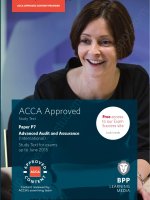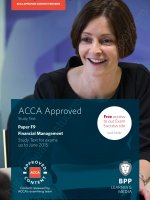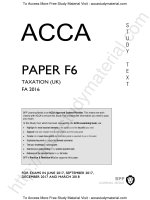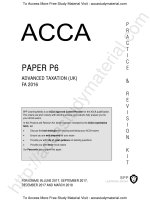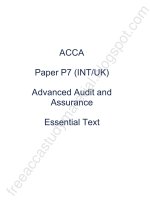ACCA f4 KAPLAN STUDY TEXT 2021 2022 by
Bạn đang xem bản rút gọn của tài liệu. Xem và tải ngay bản đầy đủ của tài liệu tại đây (8.11 MB, 303 trang )
FREE ACCA KAPLAN EXAM KIT 2017-2018 Click for Download
ACCA
Paper F4 ENG
Corporate and Business Law
Complete Text
Join OUR Facebook Page To Stay Updated About latest Study Materials
/>
FREE ACCA KAPLAN EXAM KIT 2017-2018 Click for Download
FREE ACCA KAPLAN EXAM KIT 2017-2018 Click for Download
Let us make our dream come true.
Our proposed project will demonstrate here..
We want to introduce website www.accalsbfvideos.com that
will contains: ACCA related all solution, but our primary focus will be;
1. LSBF Lectures,
2. LSBF Revision Lectures,
3. LSBF Course Notes,
4. LSBF Revision Kit,
5. Past paper solutions,
6. BPP Study Text with Kit
7. Kaplan study text with kit,
8. Others useful lectures, like mapit, accowtancy,opentuitionetc
. 9. Exam suggestion & Mock by ALP
10. Short Notes , Smart Notes & Much More
Join OUR Facebook Page To Stay Updated About latest Study Materials
/>FREE ACCA KAPLAN EXAM KIT 2017-2018 Click for Download
FREE ACCA KAPLAN EXAM KIT 2017-2018 Click for Download
Contents
Page
Chapter 1
English legal system
Chapter 2
Contract law
25
Chapter 3
The law of torts
77
Chapter 4
Employment law
103
Chapter 5
Agency law
133
Chapter 6
Types of Business Organisation
143
Chapter 7
Corporations and legal personality
157
Chapter 8
Capital and financing
199
Chapter 9
Directors
223
Chapter 10
Corporate administration
241
Chapter 11
Insolvency
255
Chapter 12
Corporate and fraudulent behaviour
269
Chapter 13
Questions & Answers
287
KAPLAN PUBLISHING
1
FREE ACCA KAPLAN EXAM KIT 2017-2018 Click for Download
iii
FREE ACCA KAPLAN EXAM KIT 2017-2018 Click for Download
iv
KAPLAN PUBLISHING
FREE ACCA KAPLAN EXAM KIT 2017-2018 Click for Download
chapter
FREE ACCA KAPLAN EXAM KIT 2017-2018 Click for Download
Introduction
FREE ACCA KAPLAN EXAM KIT 2017-2018 Click for Download
v
FREE ACCA KAPLAN EXAM KIT 2017-2018 Click for Download
Introduction
How to Use the Materials
These Kaplan Publishing learning materials have been carefully designed to
make your learning experience as easy as possible and to give you the best
chances of success in your examinations.
The product range contains a number of features to help you in the study
process. They include:
(1) Detailed study guide and syllabus objectives
(2) Description of the examination
(3) Study skills and revision guidance
(4) Complete text or essential text
(5) Question practice
The sections on the study guide, the syllabus objectives, the examination
and study skills should all be read before you commence your studies. They
are designed to familiarise you with the nature and content of the
examination and give you tips on how to best to approach your learning.
The complete text or essential text comprises the main learning
materials and gives guidance as to the importance of topics and where
other related resources can be found. Each chapter includes:
vi
•
The learning objectives contained in each chapter, which have been
carefully mapped to the examining body's own syllabus learning
objectives or outcomes. You should use these to check you have a clear
understanding of all the topics on which you might be assessed in the
examination.
•
The chapter diagram provides a visual reference for the content in the
chapter, giving an overview of the topics and how they link together.
•
The content for each topic area commences with a brief explanation or
definition to put the topic into context before covering the topic in detail.
You should follow your studying of the content with a review of the
illustration/s. These are worked examples which will help you to
understand better how to apply the content for the topic.
•
Test your understanding sections provide an opportunity to assess
your understanding of the key topics by applying what you have learned
to short questions. Answers can be found at the back of each chapter.
KAPLAN PUBLISHING
FREE ACCA KAPLAN EXAM KIT 2017-2018 Click for Download
FREE ACCA KAPLAN EXAM KIT 2017-2018 Click for Download
•
Summary diagrams complete each chapter to show the important
links between topics and the overall content of the paper. These
diagrams should be used to check that you have covered and
understood the core topics before moving on.
•
Question practice is provided at the back of each text.
Quality and accuracy are of the utmost importance to us so if you spot an
error in any of our products, please send an email to
with full details, or follow the link to the
feedback form in MyKaplan.
Our Quality Coordinator will work with our technical team to verify the error
and take action to ensure it is corrected in future editions.
Icon Explanations
Definition – Key definitions that you will need to learn from the core content.
Key Point – IIdentifies topics that are key to success and are often
examined.
Expandable Text – Expandable text provides you with additional
information about a topic area and may help you gain a better
understanding of the core content. Essential text users can access this
additional content online (read it where you need further guidance or skip
over when you are happy with the topic)
Illustration – Worked examples help you understand the core content
better.
Test Your Understanding – Exercises for you to complete to ensure that
you have understood the topics just learned.
Tricky Topic – When reviewing these areas care should be taken and all
illustrations and test your understanding exercises should be completed to
ensure that the topic is understood.
Online subscribers
Our online resources are designed to increase the flexibility of your learning
materials and provide you with immediate feedback on how your studies
are progressing.
KAPLAN PUBLISHING
FREE ACCA KAPLAN EXAM KIT 2017-2018 Click for Download
vii
FREE ACCA KAPLAN EXAM KIT 2017-2018 Click for Download
Introduction
If you are subscribed to our online resources you will find:
(1) Online referenceware: reproduces your Complete or Essential Text on
line, giving you anytime, anywhere access.
(2) Online testing: provides you with additional online objective testing so
you can practice what you have learned further.
(3) Online performance management: immediate access to your online
testing results. Review your performance by key topics and chart your
achievement through the course relative to your peer group.
Ask your local customer services staff if you are not already a subscriber
and wish to join.
Study skills and revision guidance
This section aims to give guidance on how to study for your ACCA exams
and to give ideas on how to improve your existing study techniques.
Preparing to study
Set your objectives
Before starting to study decide what you want to achieve the type of pass
you wish to obtain. This will decide the level of commitment and time you
need to dedicate to your studies.
Devise a study plan
Determine which times of the week you will study.
Split these times into sessions of at least one hour for study of new material.
Any shorter periods could be used for revision or practice.
Put the times you plan to study onto a study plan for the weeks from now until
the exam and set yourself targets for each period of study in your sessions
make sure you cover the course, course assignments and revision.
If you are studying for more than one paper at a time, try to vary your
subjects as this can help you to keep interested and see subjects as part of
wider knowledge.
When working through your course, compare your progress with your plan
and, if necessary, replan your work (perhaps including extra sessions) or, if
you are ahead, do some extra revision/practice questions.
viii
KAPLAN PUBLISHING
FREE ACCA KAPLAN EXAM KIT 2017-2018 Click for Download
FREE ACCA KAPLAN EXAM KIT 2017-2018 Click for Download
Effective studying
Active reading
You are not expected to learn the text by rote, rather, you must understand
what you are reading and be able to use it to pass the exam and develop
good practice. A good technique to use is SQ3Rs Survey, Question,
Read, Recall, Review:
(1) Survey the chapter – look at the headings and read the introduction,
summary and objectives, so as to get an overview of what the chapter
deals with.
(2) Question – whilst undertaking the survey, ask yourself the questions
that you hope the chapter will answer for you.
(3) Read through the chapter thoroughly, answering the questions and
making sure you can meet the objectives. Attempt the exercises and
activities in the text, and work through all the examples.
(4) Recall – at the end of each section and at the end of the chapter, try to
recall the main ideas of the section/chapter without referring to the text.
This is best done after a short break of a couple of minutes after the
reading stage.
(5) Review – check that your recall notes are correct.
You may also find it helpful to reread the chapter to try to see the topic(s) it
deals with as a whole.
Notetaking
Taking notes is a useful way of learning, but do not simply copy out the text.
The notes must:
•
•
•
•
•
be in your own words
be concise
cover the key points
be wellorganised
be modified as you study further chapters in this text or in related ones.
Trying to summarise a chapter without referring to the text can be a useful
way of determining which areas you know and which you don't.
KAPLAN PUBLISHING
FREE ACCA KAPLAN EXAM KIT 2017-2018 Click for Download
ix
FREE ACCA KAPLAN EXAM KIT 2017-2018 Click for Download
Introduction
Three ways of taking notes:
Summarise the key points of a chapter.
Make linear notes – a list of headings, divided up with subheadings listing
the key points. If you use linear notes, you can use different colours to
highlight key points and keep topic areas together. Use plenty of space to
make your notes easy to use.
Try a diagrammatic form – the most common of which is a mindmap. To
make a mindmap, put the main heading in the centre of the paper and put a
circle around it. Then draw short lines radiating from this to the main sub
headings, which again have circles around them. Then continue the process
from the subheadings to subsubheadings, advantages, disadvantages,
etc.
Highlighting and underlining
You may find it useful to underline or highlight key points in your study text –
but do be selective. You may also wish to make notes in the margins.
Revision
The best approach to revision is to revise the course as you work through it.
Also try to leave four to six weeks before the exam for final revision. Make
sure you cover the whole syllabus and pay special attention to those areas
where your knowledge is weak. Here are some recommendations:
Read through the text and your notes again and condense your notes into
key phrases. It may help to put key revision points onto index cards to look
at when you have a few minutes to spare.
Review any assignments you have completed and look at where you lost
marks – put more work into those areas where you were weak.
Practise exam standard questions under timed conditions. If you are short of
time, list the points that you would cover in your answer and then read the
model answer, but do try to complete at least a few questions under exam
conditions.
Also practise producing answer plans and comparing them to the model
answer.
If you are stuck on a topic find somebody (a tutor) to explain it to you.
Read good newspapers and professional journals, especially ACCA's
Student Accountant – this can give you an advantage in the exam.
x
KAPLAN PUBLISHING
FREE ACCA KAPLAN EXAM KIT 2017-2018 Click for Download
FREE ACCA KAPLAN EXAM KIT 2017-2018 Click for Download
Ensure you know the structure of the exam – how many questions and of
what type you will be expected to answer. During your revision attempt all
the different styles of questions you may be asked.
Further reading
You can find further reading and technical articles under the student section
of ACCA's website.
Paper introduction
Paper background
The aim of ACCA Paper F4 (ENG), Corporate and Business Law, is to
develop knowledge and skills in the understanding of the general legal
framework, and of specific legal areas relating to business, recognising the
need to seek further specialist legal advice where necessary.
Objectives of the syllabus
•
Identify the essential elements of the legal system including the main
sources of law.
•
Recognise and apply the appropriate legal rules relating to the law of
obligations.
•
•
Explain and apply the law relating to employment relationships.
•
Recognise and compare types of capital and the financing of
companies.
•
Describe and explain how companies are managed, administered and
regulated.
•
•
Recognise the legal implications relating to insolvency law.
Distinguish between alternative forms and constitutions of business
organisations.
Demonstrate an understanding of corporate and fraudulent behaviour.
Core areas of the syllabus
•
•
•
•
•
•
•
•
Essential elements of the legal system.
The law of obligations.
Employment law.
The formation and constitution of business organisations.
Capital and the financing of companies.
Management, administration and the regulation of companies.
Insolvency law.
Corporate and fraudulent behaviour.
KAPLAN PUBLISHING
FREE ACCA KAPLAN EXAM KIT 2017-2018 Click for Download
xi
FREE ACCA KAPLAN EXAM KIT 2017-2018 Click for Download
Introduction
Syllabus objectives
1
We have reproduced the ACCA's syllabus below, showing where the
objectives are explored within this book. Within the chapters, we have
broken down the extensive information found in the syllabus into easily
digestible and relevant sections, called Content Objectives. These
correspond to the objectives at the beginning of each chapter.
Syllabus learning objective Chapter reference
A ESSENTIAL ELEMENTS OF THE LEGAL SYSTEM
1 Law and the legal system
1
(a) Define law and distinguish types of law.[1]
1
(b) Explain the structure and operation of the courts.[1]
2 Sources of law
(a) Explain what is meant by case law and precedent.[1]
1
(b) Explain legislation and evaluate delegated legislation.[1]
1
(c) Illustrate the rules and presumptions used by the courts in
interpreting statutes.[1]
1
(d) Identify the concept and impact of human rights law.[1]
1
B THE LAW OF OBLIGATIONS
1 Formation of contract
2
(a) Analyse the nature of a simple contract.[2]
(b) Explain the meaning of an offer and distinguish it from an invitation 2
to treat.[2]
2
(c) Explain the termination of an offer.[2]
(d) Explain the meaning and consequence of acceptance.[2]
2
(e) Explain the need for consideration.[2]
2
(f)
2
Explain adequacy and sufficiency of consideration.[2]
2
(g) Analyse the doctrine of privity.[2]
(h) Distinguish the presumptions relating to intention to create legal
relations.[2]
2 Content of contracts
2
(a) Distinguish terms from mere representations.[1]
2
(b) Define the various contractual terms.[1]
2
(c) Explain the effect of exclusion clauses and evaluate their control.[2] 2
xii
KAPLAN PUBLISHING
FREE ACCA KAPLAN EXAM KIT 2017-2018 Click for Download
FREE ACCA KAPLAN EXAM KIT 2017-2018 Click for Download
3 Breach of contract and remedies
(a) Explain the ways in which a contract may be discharged.[2]
2
(b) Explain the meaning and effect of breach of contract, and the
remedies available in common law.[2]
2
(c) Explain the rules relating to the award of damages.[2]
2
(d) Analyse the equitable remedies for breach of contract.[2]
4 The law of torts and professional negligence
2
(a) Explain the meaning of tort.[2]
3
(b) Explain the tort of ‘passing off’.[2]
3
(c) Explain the tort of negligence including the duty of care and its
breach, and the concept of vicarious liability.[2]
3
(d) Explain the meaning of causality and remoteness of damage.[2]
3
(e) Discuss defences to actions in negligence.[2]
3
(f)
Explain and analyse the duty of care of accountants and auditors.[2] 3
C EMPLOYMENT LAW
1 Contract of employment
(a) Distinguish between employees and the selfemployed.[2]
4
(b) Explain the nature of the contract of employment and common law 4
and statutory duties placed on the employer and employee.[2]
2 Dismissal and redundancy
4
(a) Explain termination of employment by notice.[2]
(b) Distinguish between summary and constructive dismissal.[2]
4
(c) Explain wrongful dismissal.[2]
4
(d) Explain unfair dismissal, including the procedure, and fair and unfair 4
reasons for dismissal.[2]
(e) Discuss the remedies available to those who have been subject to 4
unfair dismissal.[2]
(f)
Explain what is meant by redundancy and the operation of the rules 4
relating to it.[2]
D THE FORMATION AND CONSTITUTION OF BUSINESS
ORGANISATIONS
1 Agency law
(a) Define the role of the agent and give examples of such relationships 5
paying particular regard to partners and company directors.[2]
5
(b) Explain the formation of the agency relationship.[2]
KAPLAN PUBLISHING
FREE ACCA KAPLAN EXAM KIT 2017-2018 Click for Download
xiii
FREE ACCA KAPLAN EXAM KIT 2017-2018 Click for Download
Introduction
5
(c) Define the authority of the agent.[2]
5
(d) Explain the potential liability of both principal and agent.[2]
2 Partnerships
(a) Demonstrate a knowledge of the legislation governing the
partnership, both unlimited and limited.[1]
6
(b) Discuss the formation of a partnership.[2]
6
(c) Explain the authority of partners in relation to partnership activity.[2] 6
6
(d) Analyse the liability of various partners for partnership debts.[2]
(e) Explain the termination of a partnership, and partners' subsequent 6
rights and liabilities.[2]
3 Corporations and legal personality
(a) Distinguish between sole traders, partnerships and companies.[2] 7
7
(b) Explain the meaning and effect of limited liability.[2]
(c) Analyse different types of companies, especially private and public 7
companies.[2]
7
(d) Illustrate the effect of separate personality and the veil of
incorporation.[2]
(e) Recognise instances where separate personality will be ignored
(lifting the veil of incorporation).[2]
4 The formation and constitution of a company
7
(a) Explain the role and duties of company promoters, and the breach 7
of those duties and remedies available to the company.[2]
(b) Explain the meaning of, and the rules relating to, preincorporation 7
contracts.[2]
(c) Describe the procedure for registering companies, both public and 7
private, including the system of streamlined registration.[1]
7
(d) Describe the statutory books, records and returns, including the
confirmation statement and the register of people with significant
control, that companies must keep or make.[1]
7
(e) Analyse the effect of a company's constitutional documents.[2]
7
(f) Describe the contents of model articles of association.[1]
7
(g) Explain how articles of association can be changed.[2]
(h) Explain the controls over the names that companies may or may not 7
use.[2]
xiv
KAPLAN PUBLISHING
FREE ACCA KAPLAN EXAM KIT 2017-2018 Click for Download
FREE ACCA KAPLAN EXAM KIT 2017-2018 Click for Download
E CAPITAL AND FINANCING OF COMPANIES
1 Share capital
(a) Examine the different types of capital.[2]
8
(b) Illustrate the difference between various classes of shares, including 8
treasury shares, and the procedure for altering class rights.[2]
(c) Explain allotment of shares, and distinguish between rights issue 8
and bonus issue of shares.[2]
(d) Examine the effect of issuing shares at either a discount, or at a
premium.[2]
2 Loan capital
8
(a) Define companies’ borrowing powers.[1]
8
(b) Explain the meaning of loan capital and debenture.[2]
8
(c) Distinguish loan capital from share capital and explain the different 8
rights held by shareholders and debenture holders.[2]
(d) Explain the concept of a company charge and distinguish between 8
fixed and floating charges.[2]
(e) Describe the need and the procedure for registering company
charges.[2]
3 Capital maintenance and dividend law
8
(a) Explain the doctrine of capital maintenance and capital reduction.[2] 8
8
(b) Explain the rules governing the distribution of dividends in both
private and public companies.[2]
F MANAGEMENT, ADMINISTRATION AND REGULATION OF
COMPANIES
1 Company directors
(a) Explain the role of directors in the operation of a company, and the 9
different types of directors, such as executive/nonexecutive
directors or de jure and de facto directors, and shadow directors.[2]
(b) Discuss the ways in which directors are appointed, can lose their 9
office and the disqualification of directors.[2]
(c) Distinguish between the powers of the board of directors, the
managing director/chief executive and individual directors to bind
their company.[2]
9
(d) Explain the duties that directors owe to their companies, and the
controls imposed by statute over dealings between directors and
their companies, including loans.[2]
9
KAPLAN PUBLISHING
FREE ACCA KAPLAN EXAM KIT 2017-2018 Click for Download
xv
FREE ACCA KAPLAN EXAM KIT 2017-2018 Click for Download
Introduction
2 Other company officers
(a) Discuss the appointment procedure relating to, and the duties and 10
powers of, a company secretary.[2]
(b) Discuss the appointment procedure relating to, and the duties and 10
rights of a company auditor, and their subsequent removal or
resignation.[2]
3 Company meetings and resolutions
10
(a) Distinguish between types of meetings: general meetings and
annual general meetings.[1]
(b) Distinguish between types of resolutions: ordinary, special, and
written.[2]
10
(c) Explain the procedure for calling and conducting company
meetings.[2]
10
G INSOLVENCY LAW
1 Insolvency and administration
11
(a) Explain the meaning of and procedure involved in voluntary
liquidation, including members' and creditors' voluntary liquidation.
[2]
(b) Explain the meaning of, the grounds for, and the procedure
involved in compulsory liquidation.[2]
11
(c) Explain the order in which company debts will be paid off on
liquidation.[2]
11
(d) Explain administration as a general alternative to winding up.[2]
11
(e) Explain the way in which an administrator may be appointed, the 11
effects of such appointment, and the powers and duties of an
administrator.[2]
H CORPORATE FRAUDULENT AND CRIMINAL BEHAVIOUR
1 Fraudulent and criminal behaviour
(a) Recognise the nature and legal control over insider dealing.[2]
12
(b) Recognise the nature and legal control over market abuse.[2]
12
(c) Recognise the nature and legal control over money laundering.[2] 12
12
(d) Recognise the nature and legal control over bribery.[2]
(e) Discuss potential criminal activity in the operation, management 12
and liquidation of companies.[2]
12
(f) Recognise the nature and legal control over fraudulent and
wrongful trading.[2]
xvi
KAPLAN PUBLISHING
FREE ACCA KAPLAN EXAM KIT 2017-2018 Click for Download
FREE ACCA KAPLAN EXAM KIT 2017-2018 Click for Download
The superscript numbers in square brackets indicate the intellectual depth
at which the subject area could be assessed within the examination. Level 1
(knowledge and comprehension) broadly equates with the Knowledge
module, Level 2 (application and analysis) with the Skills module and Level
3 (synthesis and evaluation) with the Professional level. However, lower level
skills can continue to be assessed as you progress through each module
and level.
The examination
Examination format
Number of marks
Section A
–25 × 2 mark objective test questions
50
–20 × 1 mark objective test questions
20
Section B
–5 × 6 mark
multitask questions
30
–––
100
Total time allowed: 2 hours
KAPLAN PUBLISHING
FREE ACCA KAPLAN EXAM KIT 2017-2018 Click for Download
xvii
chapter
1
FREE ACCA KAPLAN EXAM KIT 2017-2018 Click for Download
English legal system
Chapter learning objectives
Upon completion of this chapter you will be able to:
•
•
explain the difference between civil and criminal law
explain the structure and operation of the civil courts and tribunal
systems
•
explain the meaning of judicial precedent, ratio decidendi and
obiter dicta
•
illustrate how the doctrine of judicial precedent works in relation
to the civil courts
•
•
explain how legislation is made and the doctrine of sovereignty
•
set out the rules and presumptions used by the courts in
interpreting statutes
identify the concept of human rights as expressed in the Human
Rights Act 1998 (HRA 1998)
FREE ACCA KAPLAN EXAM KIT 2017-2018 Click for Download
1
FREE ACCA KAPLAN EXAM KIT 2017-2018 Click for Download
English legal system
1 Definition of Law
The principles and regulations established in a community by some authority
and applicable to its people whether in the form of legislation or of custom
and policies recognised and enforced by judicial decision.
2 Types of Law
The English legal system distinguishes several types of law. The ones we
will look at are:
•
•
•
2
Common law and equity
Private law and public law
Criminal law and civil law
KAPLAN PUBLISHING
FREE ACCA KAPLAN EXAM KIT 2017-2018 Click for Download
FREE ACCA KAPLAN EXAM KIT 2017-2018 Click for Download
chapter 1
Common law and equity
Following the Norman conquest, English law has been described as a
common law system. This was a system whereby a number of legal
concepts from Norman law were incorporated into the English system.
Common law:
•
•
•
•
developed from local customs
introduced the system of precedent (see section 4)
the only remedy is damages
may be rigid and inflexible.
Judges would travel around the country and apply a mixture of precedent
and common sense to build up a body of internally consistent law. However,
this would sometimes result in harsh consequences.
To deal with the issue that damages are not always a suitable remedy,
equity was developed two or three hundred years later after common law
and introduced fairness into the English legal system.
Equity:
•
developed as a petition by a party who felt the common law had led to
injustice
•
•
it is more flexible than the common law
•
it is concerned with fairness and therefore will not be granted if there is
undue delay in bringing the case or if the petitioner has himself acted
unfairly, or where there is no mutuality (both parties should be able to
bring a case).
it introduced new discretionary remedies, e.g. injunctions and specific
performance
Private and public law
Within the English legal system, two distinct areas of law operate: private
and public law. They both aim to create social order, but have a number of
distinct differences.
Within public law, different categories exist. These include criminal law,
constitutional law, administrative law, social welfare law and all deal with
matters relating to the whole country.
KAPLAN PUBLISHING
FREE ACCA KAPLAN EXAM KIT 2017-2018 Click for Download
3
FREE ACCA KAPLAN EXAM KIT 2017-2018 Click for Download
English legal system
Private law is concerned with the law enforced between individuals. This can
include contract law, family law and other areas which deal with intellectual
property rights (copyrights, designs and patents), land law (and the way in
which it is transferred), probate (dealing with wills and how property is
distributed after someone dies) and company law (which deals with the
ways in which companies are created and rules regulating how they operate
their business).
Criminal law versus civil law
Criminal law
Civil law
Criminal law relates to conduct of
which the State disapproves and
which it seeks to control. It is a
form of public law.
Civil law is a form of private law and
involves the relationships between
individual citizens.
Purpose – to settle disputes
Purpose – the enforcement of
particular forms of behaviour by the between individuals and to provide
remedies.
State, which acts to ensure
compliance.
In criminal law the case is brought
by the State in the name of the
Crown. A criminal case will be
reported as Regina v ..., where
Regina means the Latin for 'queen'.
In civil law the case is brought by the
claimant, who is seeking a remedy.
The case will be referred to by the
names of the parties involved in the
dispute, such as Brown v Smith.
Burden of proof – on the
prosecution.
Burden of proof – on the claimant.
Standard of proof – guilt must be Standard of proof – liability must be
shown beyond reasonable doubt shown on the balance of
probabilities (lower standard of
(high standard of proof).
proof).
Object – to regulate society by the Object – usually financial
compensation to put the claimant in
threat of punishment.
the position he would have been in
had the wrong not occurred.
If found guilty the criminal court will
sentence the accused and it may
fine him or impose a period of
imprisonment. If innocent the
accused will be acquitted.
4
The civil court will order the defendant
to pay damages or it may order
some other remedy, e.g. specific
performance or injunction.
KAPLAN PUBLISHING
FREE ACCA KAPLAN EXAM KIT 2017-2018 Click for Download
FREE ACCA KAPLAN EXAM KIT 2017-2018 Click for Download
chapter 1
Test your understanding 1
(1) Which one of the following statements is correct?
A
The aim of the criminal law is to regulate behaviour within
society by the threat of punishment.
B
The aim of the criminal law is to punish offenders.
C
The aim of the criminal law is to provide a means whereby
injured persons may obtain compensation.
D
The aim of the criminal law is to ensure that the will of the
majority is imposed upon the minority.
3 The court system
The main English civil courts
The following diagram shows the main civil courts. The term ‘first instance’
refers to the court in which the case is first heard. Appeals are heard in a
different court. The arrows show the way a case will progress through the
court system.
KAPLAN PUBLISHING
FREE ACCA KAPLAN EXAM KIT 2017-2018 Click for Download
5
FREE ACCA KAPLAN EXAM KIT 2017-2018 Click for Download
English legal system
The House of Lords was replaced by the Supreme Court on 1 October
2009. This new court has assumed the judicial functions of the House of
Lords. The Law Lords that used to sit in the House of Lords now sit as
twelve Justices of the Supreme Court, with a President at its head.
The Supreme Court was established by the Constitutional Reform Act 2005.
It was felt that there needed to be a separation of powers between the
judicial functions of the House of Lords (to decide issues in relation to the
law) and the legislative functions of the House of Lords (to make the law) to
give assurance of the independence of the judges.
The Supreme Court is now in a separate building from the House of Lords
and has its own appointment system, staff and budget.
6
KAPLAN PUBLISHING
FREE ACCA KAPLAN EXAM KIT 2017-2018 Click for Download
FREE ACCA KAPLAN EXAM KIT 2017-2018 Click for Download
chapter 1
The threetrack system
When a claim is received, it will be allocated to one of three tracks for the
hearing.
(1) The small claims track – deals with simple claims valued at no more
than £10,000, an informal court.
(2) The fasttrack – deals with moderately valued claims of between
£10,000 and £25,000, expected to last no more than one day.
(3) The multitrack – deals with claims of over £25,000 and/or complex
claims.
Note: the County court deals with all cases allocated to the small claims
track, the majority of fast track and some multi track cases. All other claims
are dealt with by the High Court.
KAPLAN PUBLISHING
FREE ACCA KAPLAN EXAM KIT 2017-2018 Click for Download
7
FREE ACCA KAPLAN EXAM KIT 2017-2018 Click for Download
English legal system
The main English criminal courts
8
KAPLAN PUBLISHING
FREE ACCA KAPLAN EXAM KIT 2017-2018 Click for Download
